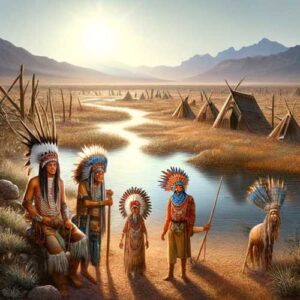Las Vegas Historical
Las Vegas in the Beginning: Nestled in the arid basin of Nevada’s Mojave Desert, Las Vegas has a history as colorful and vibrant as its famed Strip. Long before the bright lights of the casinos, the area was a verdant oasis, a lifeline in the desert for the indigenous Southern Paiute people. The name ‘Las Vegas’ itself, Spanish for ‘The Meadows’, hints at its green past, a far cry from the neon-lit metropolis we know today.
The roots of modern Las Vegas trace back to the 1800s. In 1829, a Mexican scout named Rafael Rivera first documented the valley as he journeyed along the Old Spanish Trail to Los Angeles. The lush area, with its abundant wild grasses and water, was a stark contrast to the surrounding desert, providing a vital respite for travelers and settlers alike.

Las Vegas Gains Momentum: It wasn’t until Nevada attained statehood in 1864 that Las Vegas began its slow transformation. The discovery of precious minerals in the surrounding areas attracted a stream of miners and settlers, seeking fortunes in a land that promised as much hardship as opportunity. The vast desert, though challenging, held a promise of new beginnings.
By the early 20th century, Las Vegas was still a modest town. The land, which was part of a Mexican land grant, had passed through various hands before being acquired by the San Pedro, Los Angeles, and Salt Lake Railroad in 1902. This acquisition marked a turning point for Las Vegas. The railroad brought with it an influx of workers and travelers, setting the stage for the city’s future growth.
Las Vegas Enters the 21st Century
Las Vegas Begins to Take Shape: The Las Vegas we recognize today began to take shape in the early 1900s. The city was officially founded on May 15, 1905, when 110 acres of land, what is now downtown Las Vegas, were auctioned off. This pivotal event laid the foundation for a rapid urban development shaping the city for decades to come.
In the 1930s, Las Vegas underwent a significant transformation with the construction of the Hoover Dam, then known as the Boulder Dam. The dam project, a colossal undertaking during the Great Depression, brought thousands of workers to the area. The influx of these workers necessitated the development of additional infrastructure and entertainment options.

Las Vegas Heads Into World War II

Las Vegas Gets Legal: The legalization of gambling in Nevada in 1931 marked another turning point for Las Vegas. Small gambling halls and casinos began to emerge, setting the stage for the city’s future reputation as a gaming and entertainment paradise. The El Rancho Vegas, opened in 1941 on what would become the Las Vegas Strip, was the first resort to offer entertainment, dining, and gaming under one roof. This is when Las Vegas really took off and never looked back.
Las Vegas Goes Full Speed Ahead: The post-war era marked the beginning of Las Vegas’s golden age. The 1950s and 60s were a time of extravagant expansion and glamour. Magnificent casinos and showgirl revues became synonymous with Las Vegas. Icons like the Sands, the Sahara, and the Tropicana rose along the Strip, each more opulent than the last. These resorts drew Hollywood celebrities and cemented Las Vegas’s reputation as an entertainment capital.
USA Wins World War II and Las Vegas is Wide Open; World War II and the subsequent growth of the nearby Nellis Air Force Base also contributed to the city’s expansion. The military personnel stationed there provided a steady stream of customers for the burgeoning casino and entertainment industry. This period saw the beginning of Las Vegas’s transformation into a destination for leisure and entertainment.
The Famous Run Las Vegas
Famous People Shaping Las Vegas: This era also saw the rise of notable figures in the city’s development. Visionaries like Howard Hughes, who invested heavily in Las Vegas real estate, played a significant role in shaping the city’s landscape. The influence of organized crime in financing and operating casinos also became an indelible part of Las Vegas’s history during this period.
The evolution of Las Vegas entertainment was marked by legendary performances by artists like Elvis Presley, Frank Sinatra, and the Rat Pack. Their shows were more than just concerts; they were cultural phenomena that drew crowds from across the nation, further solidifying Las Vegas’s status as an entertainment powerhouse.
Historical Landmarks of Las Vegas Take Shape
Enter Modern Era Las Vegas: The 1980s brought a new wave of development. The vision of creating family-friendly destinations led to the emergence of mega-resorts like The Mirage, which opened in 1989. These resorts offered a variety of attractions beyond gaming, including elaborate shows, shopping centers, and themed environments, appealing to a broader audience.
As the 20th century drew to a close, Las Vegas continued to reinvent itself. The 1990s and early 2000s saw the rise of even more spectacular resorts like the Bellagio, The Venetian, and The Palazzo. These resorts focused on providing a luxurious, all-encompassing experience, featuring world-class dining, shopping, and entertainment.
The city’s appeal extended beyond gaming and entertainment. Las Vegas became a sought-after destination for conventions and business conferences, thanks to its vast hotel capacities and state-of-the-art facilities. The Las Vegas Convention Center, one of the largest in the world, hosts hundreds of events annually, drawing millions of business travelers.
New Era for Las Vegas. Today, Las Vegas stands as a testament to human ingenuity and the pursuit of entertainment. It’s a city that never sleeps, constantly evolving and adapting. From its humble beginnings as a railroad town to a global entertainment capital, Las Vegas’s story is one of transformation, resilience, and ceaseless innovation.
As we look forward, Las Vegas pushes the boundaries of what is possible in hospitality and entertainment. New resorts, innovative technology, and sustainable practices, the city is poised to remain a beacon of excitement for generations to come. Las Vegas, a desert city, has become an enduring symbol of the American dream – a place where anything is possible.
Historical Locations of Las Vegas

Hoover / Boulder Dam

Springs Preserve

